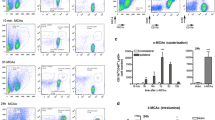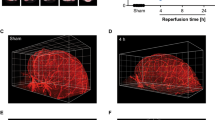Abstract
According to Fisher [1], the word infarct was first used by Laennec in 1835 to describe a pulmonary lesion that had developed in association with the occlusion of a pulmonary artery. The word “infarct” (from Latin, infarcere) means to stuff; therefore, it is unclear whether Laennec applied the term “infarctus” to describe the parenchymal pulmonary lesion or the “stuffed,” occluded pulmonary artery. Nonetheless, several years later Litten [2] used the word “infarct” to describe areas of softening in the kidney and liver that were accompanied by occlusion of the corresponding arterial branches.
Access this chapter
Tax calculation will be finalised at checkout
Purchases are for personal use only
Preview
Unable to display preview. Download preview PDF.
Similar content being viewed by others
References
Fisher CM (1988) The history of cerebral embolism and hemorrhagic infarction. In: Furlan AJ (ed) The heart and stroke. Springer-Verlag, Berlin Heidelberg London, pp 1–14
Litten M (1880) Untersuchunge uber der hemorrhagischen Infarct and uber die Einwirkung arterieller Anaemie awf das Lebende Gewebe. Z Klin Med 1: 131–227
Dorland’s illustrated medical dictionary, 26th edn (1985) Saunders, Philadelphia, p 101
Cotran RS, Kumar V, Robbins SL (1989) Fluid and hemodynamic derangements. In: Cotran RS, Kumar V, Robbins SL (eds) Robbins pathologic basis of disease. Saunders, Philadelphia, p 111
Sacco RL, Ellenberg JH, Mohr JP, Tatemichi TK, Hier DB, Price TR, Wolf PA (1989) Infarcts of undetermined cause: the NINCDS stroke data bank. Ann Neurol 25: 382–390
Garcia JH (1990) Trombosis venosa intracraneal. In: Matias-Guiu J, Martinez-Vila E, Marti-Vilalta J (eds) Isquemia cerebral. MCR, Barcelona, pp 203–215
Garcia JH (1991) Thrombosis of cranial veins and sinuses: the brain parenchymal effects. In: Baethmann A, Kempski O, Einhäupl K (eds) Experimental and clinical aspects of cerebral sinus thrombosis. Plenum, New York, pp 27–38
Kirino T (1982) Delayed neuronal death in the gerbil hippocampus following ischemia. Brain Res 239: 57–69
Steegman AT (1968) The neuropathology of cardiac arrest. In: Minckler J (ed) Pathology of the nervous system, vol 1. McGraw-Hill, New York
Garcia JH (1988) Morphology of global cerebral ischemia: a review. Crit Care Med 16: 979–987
Sundt TM, Sharbrough FW, Piepgras DG, Kearns TP, Messick JM, O’Fallon WM (1981) Correlation of cerebral blood flow and electro-encephalographic changes during carotid endarterectomy with results of surgery and hemodynamics of cerebral ischemia. Mayo Clin Proc 56: 533–543
Mohr JP, Gauthier JC, Hier DB (1992) Middle cerebral artery disease. In: Barnett HJM, Mohr JP, Stein BM, Yatsu FM (eds) Stroke: pathophysiology, diagnosis, and management, 2nd edn. Churchill Livingstone, New York, pp 361–418
Koizumi J, Yoshida Y, Nakazawa T, Ooneda G (1986) Experimental studies of ischemic brain edema. 1. A new experimental model of cerebral embolism in rats in which recirculation can be introduced in the ischemic area. Jpn J Stroke 8: 1–8
Zea-Longa E, Weinstein PR, Carlson S, Cummings R (1989) Reversible middle cerebral artery occlusion without craniectomy in rats. Stroke 20: 84–91
Garcia JH, Yoshida Y, Chen H, Li Y, Zhang ZG, Lian J, Chen S, Chopp M (1993) Progression from ischemic injury to infarct following middle cerebral artery occlusion in the rat. Am J Pathol 142: 623–635
Garcia JH, Liu K, Yoshida Y, Lian J, Chen S, del Zoppo GJ (1994) Influx of leukocytes and platelets in an evolving brain infarct ( Wistar rat ). Am J Pathol 144: 188–199
Garcia JH, Liu K, Lian J, Xu J (1993) Astrocytic and micróvascular responses to the occlusion of a middle cerebral artery ( Wistar rat) (abstract ). J Neuropathol Exp Neurol 52: 288
Garcia JH, Joseph R, Herpolsheimer B, Liu KF, Ho KL (1994) Neuronal ischemic injury to the brain after focal ischemia: Apoptosis or necrosis (?) (abstract). Stroke 25: 260
Farber JL. Martin JT, Chien KR (1978) Irreversible ischemic cell injury. Am J Pathol 92: 713–724
Garcia JH, Wagner S, Liu K-F. Hu X-J (1995) The neurologic deficit and the extent of neuronal necrosis attributable to middle-cerebral-artery occlusion: statistical validation. Stroke 26: 627–635
Schmid-Schönbein GW, Engler RL (1987) Granulocytes as active participants in acute myocardial ischemia and infarction. Am J Cardiovasc Pathol 1: 15–30
del Zoppo GJ, Schmid-Schönbein GW. Mori E, Copeland BR, Chang CM (1991) Polymorphonuclear leukocytes occlude capillaries following middle cerebral artery occlusion and reperfusion in baboons. Stroke 22:1276–1283
Mori E, del Zoppo GJ, Chambers JD, Copeland BR, Arfors KE (1993) Inhibition of polymorphonuclear leukocyte adherence suppresses no-reflow after focal cerebral ischemia in baboons. Stroke 23: 712–718
Ward PA (1991) Mechanisms of endothelial cell killing by H2O2 or products of activated neutrophils. Am J Med 91: 89–94
Dereski M, Chopp M, Knight R, Chen H, Garcia JH (1992) Focal cerebral ischemia in the rat: temporal profile of neutrophil responses. Neurosci Res Commun 11: 179–186
Author information
Authors and Affiliations
Editor information
Editors and Affiliations
Rights and permissions
Copyright information
© 1995 Springer-Verlag Tokyo
About this paper
Cite this paper
Garcia, J.H., Liu, KF., Hu, XJ. (1995). Time Course of Leukocyte Influx Following Middle Cerebral Artery Occlusion in the Wistar Rat. In: Yamaguchi, T., Mori, E., Minematsu, K., del Zoppo, G.J. (eds) Thrombolytic Therapy in Acute Ischemic Stroke III. Springer, Tokyo. https://doi.org/10.1007/978-4-431-68459-6_1
Download citation
DOI: https://doi.org/10.1007/978-4-431-68459-6_1
Publisher Name: Springer, Tokyo
Print ISBN: 978-4-431-70139-2
Online ISBN: 978-4-431-68459-6
eBook Packages: Springer Book Archive




